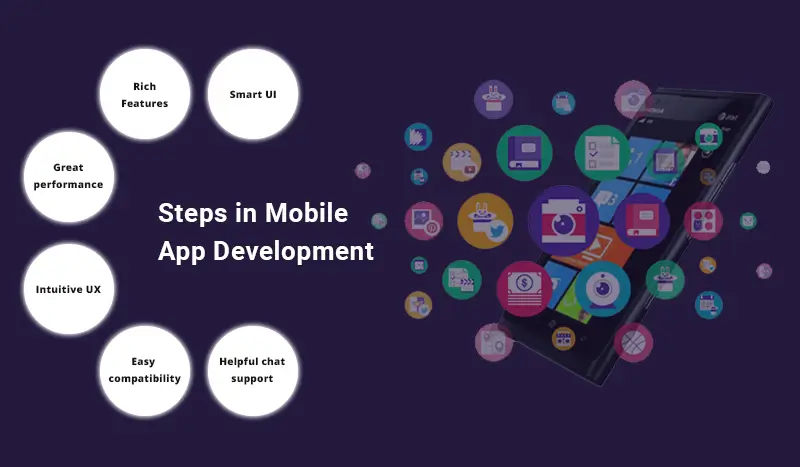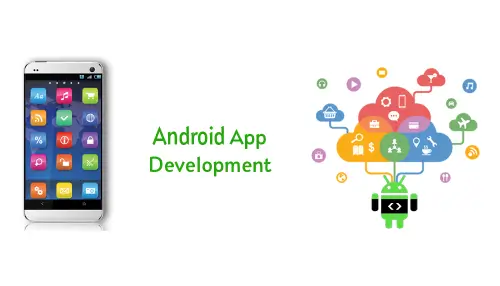The act or process of creating a mobile app for mobile devices, such as a personal digital assistant, or mobile phone, is known as Mobile App Development. These software programs are created to function on portable electronics like smartphones and tablets. These programs can be supplied as a web applications using server-side or client-side processing to provide an “application-like” experience within a web browser, or they can be pre-installed on phones during the manufacturing process.
Mobile user interface design is a crucial component of the development process for mobile apps. Constraints, contexts, screens, input, and mobility are taken into account while designing for mobile devices. The interface of a device includes both physical and software elements, with the user frequently at the center of interaction. Users can influence a system through user input, and the system can show the results of their manipulation through device output. Limited attention spans and form factors, such as the size of a mobile device’s screen for a user’s hand are limits for mobile user interface design.
Four Important Stages in the Development of a Mobile App
1. Research on the market and discovery
Since there are now mobile app developers, it is crucial to invest time and money in conducting a complete market analysis and evaluating the project’s sustainability. Market research may also result in the creation of novel ideas.
2. UX/UI Design for Apps
User interface and experience design are two crucial factors that affect a mobile app’s performance. UX design focuses on many facets of user interaction with the program, whereas UI design is concerned with the digital format in which the app is manifested to the consumer.
3. App Creation
The app’s distinct reality and coding serve as its focal point. The production process includes designing several lines of code, worth a try, making the software that can be downloaded and tested, and creating the development platform
4. App QA and testing
Screening is yet another important step in the development of a smartphone gadget. Testing assesses the consistency of the app and determines how effective or ineffective it is. Depending on how the manufacturing is planned and executed, the system testing stage and the production stage may overlap in a number of ways.
Processes used by Mobile App Development Company
These are steps used by Mobile App Development Company:
Step 1: Verifying the concept
Answer the questions below before you start to make sure the idea is beneficial for your time and effort and that you aren’t just marrying the wrong opinion. What inspires you to create a mobile application, exactly? Is that actually required in your business? Is the concept appropriate or a good fit for the organization’s requirements or target market? Will you have the money to support it?
-
i. Target Market: Who are you trying to contract? Are the potential customers interested, too?
ii. App USP: What are the app’s primary features? What is the key selling point of the application? What makes your target market use and download your app then? How do you differentiate yourself?
iii. Analyzing rivals: Who the competition is? Do they have something similar?
Step 2: Market Research
The most important part of your journey must be finished now or never. Market research reveals the actual need or interest of the market, allowing you to adjust your concept. The analysis will also give you a short list of criteria to use as a guide as you organise your work.
Step 3: Create the Wireframe for Your App
It is time to give your thoughts with wireframes once you have completed your list of concepts. Phases of Mobile App Development may serve as a model for your program. This will show off your app’s functionality and how it looks and feels. It will also help you understand how the application works and how it looks.
Step 4: Selecting a Platform
We’ll help you select the right platform for the various stages for various stages of developing a mobile application.
Step 5: Creation
If your idea for a mobile app passes system testing, it is time to provide your dream project with a solid foundation. This procedure involves. If your idea for a smartphone app passes system testing, it’s a means to provide your design project with a correct framework. The actual coding and execution of the application are also part of this process.
Step 6: Improve Your App after Testing
A source code process that was in place during production made sure there were no significant defects that needed to be fixed later. Here is the progress of our project, which incorporates functional testing into the design process on a daily basis.
Step 7: Release Your App’s Beta Version
Any product’s current owners will be drawn to a beta version, which is essential for making the smartphone app popular. Early investors are well-versed in the advantages and disadvantages of your program.
Step 8: Launching your app
You have planned, reviewed, and developed your application. It should be added to the google play store right away.
Step 9: Post-lunch Activities
The most crucial action after releasing your smartphone gadget is marketing it. If people are not aware of your software they cannot use it. To aid the spreading of the word and encourage others to test your app, think about creating engaging and insightful videos.
USP of OdiTek as a leading Mobile App Development Company
-
i. End-to-end design, development, and product launching services for mobility
ii. Highly experienced team on both native as well as hybrid platforms
iii. Long experience in developing mobile apps in different verticals like Healthcare, Healthcare Insurance, and Enterprise-grade mobility
iv. Creative User Experience design
v. Core expertise in Native Android and Native iOS app development
Conclusion
The process of creating a mobile application may appear complicated and overwhelming. There are numerous steps and challenging choices must be made along the route. However, the process is incredibly fulfilling and can be very useful and business-enriching.
OdiTek is proficient in all mobile platforms and has been involved in mobile app development since its inception. We construct mobile apps using agile software development techniques and provide high-performance, highly intuitive mobile apps with a smart UI and glitch-free user experience.
Reach out to us today to know more







